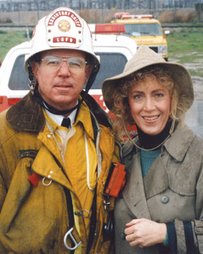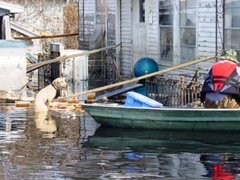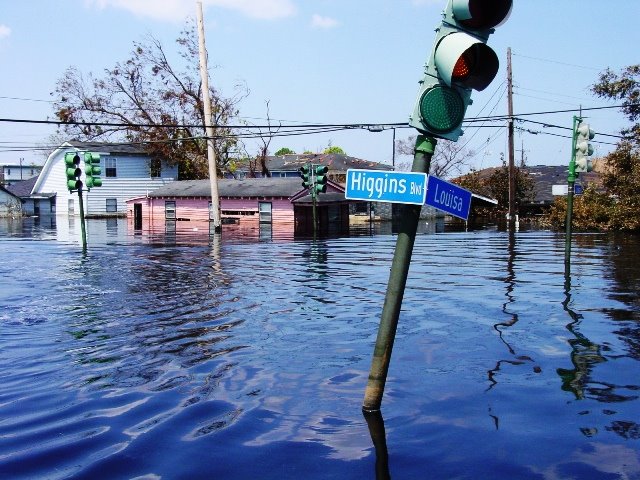Swiftwater, Swift Rescue
By Nancy J. Rigg
After dozens of swiftwater fatalities, Los Angeles-area rescuers teamed to improve response
PHOTO JOHN DE LEON
On Feb. 17, 1980, my fiancé, Earl Higgins, and I watched two young boys ride their bicycles perilously close to the edge of the flood-swollen Los Angeles River. One boy fell into the deluge and cried out for help. Instinctively, Earl stepped into the churning water to rescue him. The stark image of man and boy careening downstream at 25 mph haunts me still. The boy somehow managed to eddy out of the water, and firefighters located him several miles downstream. Earl was swept away; his remains were recovered an agonizing nine months later.
How did the boy survive? Where along the 30-mile stretch of river from Griffith Park to Long Beach did Earl succumb to the torrent's relentless power? And why weren't rescuers able to save him?
These questions lingered in my mind as I slowly rebuilt my life following the flood disaster that cost Earl and more than 30 other victims their lives.
In the early 1980s, Los Angeles endured several successive years of flooding. I counted the dead, wincing when the numbers climbed to more than a dozen one year and 16–18 the next. With few exceptions, everyone who slipped or fell into the maze of open, cement-lined flood control channels that crisscross Los Angeles perished.
Treading Water
On the first anniversary of Earl's death, I wrote an article for the Los Angeles Times in which I begged parents to mind their children when storms slam into Southern California. Los Angeles County Lifeguard Mickey Gallagher contacted me after reading the piece and confirmed my suspicions about the lack of a coordinated response plan for flood rescues in local inland flood-control channels and other waterways.
Gallagher explained that county lifeguards, who had water-rescue experience, were dispatched to incidents involving inland flooding. But deployed firefighters and police officers lacked the training necessary to do anything more than make lucky saves. Rescues were hit and miss, Gallagher says. "The flood control channels were a kind of no-man's land, and if someone got swept away, which happened every time we got heavy rains, their chance of survival was slim to none."
Gallagher and a handful of other Southern California lifeguards tried for several years to introduce swiftwater rescue training in Los Angeles. In the late '70s, Gallagher had met with Jim Segerstrom, a whitewater rescue and mountain search and rescue specialist in the process of establishing Rescue 3 International, a swiftwater rescue training business.
"We discussed ideas and tried various rescue techniques," Gallagher says. "Los Angeles County has 470 miles of cement-lined, open flood-control channels that wind through multiple jurisdictions. We knew that the only way to approach this was for all the public safety agencies to work together. But we just couldn't get enough attention focused on this problem."
Los Angeles County Fire Department (LACoFD) Captain Larry Collins also recognized the need to better train and equip firefighters. "In the '80s a lot of fire chiefs were reluctant to undertake swiftwater rescue as a responsibility," Collins says. "There was no mission statement or funding set by the county or local city charters that said we had to do this. There wasn't even any formal training available until Rescue 3 started to develop their program." However, after intense storms in 1982 and '83 killed more than a dozen people in flood control channels, Collins was tasked by his department to develop a swiftwater rescue program.
The same devastating storms also inspired the Los Angeles County Sheriff's Department (LASD) to experiment with a variety of progressive flood-rescue techniques and tools, including helicopters. "Pursuit rescues in flood-control channels are among the most difficult rescues to perform," Deputy Terry Ascherin of LASD's Emergency Services Detail (ESD) says. "For years no one was willing to admit that helicopters could play an important role in swiftwater rescues where the victim is being rapidly swept downstream." Ascherin credits LASD commanders at ESD and the department's Aero Bureau for allowing rescue paramedics and pilots to experiment in the '80s and "come up with new protocols for something that had never been done before."
PHOTO JOHN DE LEON
The Los Angeles County Sheriff’s Department was one of the first agencies to use helicopters for swiftwater rescues.
Droughts Delay Progress
In 1985, as a few individual agencies began to focus on swiftwater and flood-rescue training, a prolonged drought hit California and urgency to move forward waned. That changed in February 1992 when a punishing series of drought-busting storms pummeled Southern California from Ventura to San Diego counties. More than a dozen people were swept to their deaths. On Feb. 10, 50 motorists traveling on a main Los Angeles thoroughfare were abruptly trapped in rapidly rising floodwaters in the Sepulveda Basin, a multi-purpose flood-control area designed to capture storm runoff. The scramble to rescue them aired live on television. I was relieved to see Los Angeles County lifeguards using inflatable rescue boats to bring victims ashore. I was elated to see Los Angeles City Fire helicopters being deployed, and thrilled to see multiple agencies working together. I called Gallagher to congratulate him, leaving a message at lifeguard headquarters.
On Feb. 12, 15-year-old Adam Bischoff's fatal journey down the flood-swollen Los Angeles River shattered my illusions of a coordinated, multi-agency flood-rescue response. Adam had grown up during the blistering drought of the late 1980s and didn't recognize the danger when floodwaters filled an arroyo (water-carved channel) near his home. The mesmerizing surge drew Adam, and like other children before him, he slipped into the torrent. The current swept him helplessly downstream for more than 10 miles — past rescuers without the training or equipment to save him.
Adam's death also unfolded live on television, clearly and painfully broadcasting rescuers' lack of preparedness and mobilizing the community in a way that no earlier flood-related tragedy ever had. Adam's remains were recovered the next morning when floodwaters receded.
With encouragement from county lifeguards and Adam Bischoff's family and friends, I formed an ad-hoc citizens group to push for reform. We met with political leaders, who suddenly wanted to know why local emergency responders were so ill-prepared to handle inland water rescues. The Los Angeles City Council and County Board of Supervisors urged local fire-rescue and law enforcement agencies to standardize and coordinate swiftwater rescue training. Emergency funds were allocated to several agencies, including LACoFD, Los Angeles City Fire Department (LAFD), LASD and the county lifeguards to purchase much-needed equipment, train emergency responders and develop a flood-safety education program to warn children about the dangers of fast moving floodwaters.
PHOTO JOHN DE LEON
More than 18 agencies comprise the Los Angeles County Swiftwater Rescue Committee. More than 7,500 fire-rescue, law enforcement and lifeguard personnel from Los Angeles-area agencies have received swiftwater rescue training following the committee’s guidelines.
Multi-Agency Swiftwater Committee
Under a directive from the Los Angeles City Council, an LAFD river rescue task force formed with LAFD Assistant Chief Tony Ennis at the helm. Its purpose: to develop training, equipment and interagency protocols for swiftwater and flood-rescue operations within the City of Los Angeles. Individual agencies developed internal protocols, but because flood victims frequently travel for miles downstream through multiple jurisdictions, a cohesive, countywide response plan proved necessary.
In 1993 a new committee — the Los Angeles County Multi-Agency Swiftwater Rescue Committee — absorbed LAFD's river rescue task force. Under the leadership of the Los Angeles County Fire Department, the Swiftwater Rescue Committee had representatives from 18 fire-rescue, law enforcement and other government agencies. Working together, committee members developed the most comprehensive multi-agency, multi-jurisdictional swiftwater rescue program in the world. In addition to standardizing rescue training, developing new rescue equipment and techniques and establishing swiftwater rescue predeployment protocols, committee members helped the Los Angeles County Office of Education and Department of Public Works develop a pioneering, curriculum-based flood safety education program called No Way Out. The program uses videos and instructional materials to educate Los Angeles-area children about the dangers of flood-control channels. The No Way Out video is also used to educate rescuers, command personnel and other emergency responders about flood-safety awareness.
Captain Steve Wood of the Glendale Fire Department cites the Swiftwater Rescue Committee's Operational Standards and Guidelines document as one of its most important accomplishments. "This document is our play book," Wood says. "It identifies, right across the board, what the level of training should be, what the equipment should be, what the communications frequencies are, what helicopters will be assigned and how they will operate with the ground-based teams. We all train to these standards."
Using the committee's guidelines, more than 7,500 fire-rescue, law enforcement and lifeguard personnel from dozens of local public safety agencies have received swiftwater rescue training. Local fire academies have incorporated swiftwater rescue training into their standard curriculum. Fire-rescue, law enforcement personnel and lifeguards with advanced swiftwater rescue training serve on multi-agency swiftwater rescue teams, which predeploy in advance of major storms, patrol and monitor the channels during high risk times and respond to calls together to ensure a seamless, multi-jurisdictional response.
"Once a year the committee hosts a flood operations day when we work with helicopters from the four primary agencies that provide air support: LACoFD, LAFD, the Sheriff's Aero Bureau and the Glendale Police Air Support Unit," says Wood. "We work with personal watercraft and inflatable rescue boats, plus we do three days of intensive, in-water training where we practice contact rescues or swimming rescues. This annual training allows all the agencies to exchange ideas, information, rescue techniques and see one another again."
Flood control channels throughout Los Angeles County have been carefully mapped, with observation, flotation and rescue locations clearly identified. To enhance safety and provide sturdy anchor points for rescuers to attach ropes and other equipment during rescue operations, the committee worked with engineers from the Los Angeles County Department of Public Works to design, build and install permanent anchoring and sliding devices at specific rescue points throughout the flood control-channel system. Civil Engineer James Yang served as project manager for the 18-month-long effort that began in February 1998. "Public Works completed installation of more than 700 rescue anchor devices at more than 100 strategic locations along the 470 miles of open flood control channels throughout Los Angeles," Yang says.
Innovation
While the Multi-Agency Swiftwater Rescue Committee oversaw the development of countywide standards, individual agencies and rescuer-inventors contributed new ideas for equipment, rescue techniques and improved means for deployment. LASD's Terry Ascherin invented the SkyHook rescue system, including a rear-mounted harness for use in helicopter-based swiftwater rescue operations. LACoFD's Rick Cearley invented the Cearley Rescue Strap, which allows rescuers to more easily capture victims in swiftwater. LAFD swiftwater rescuers experimented with personal watercraft in the cement-lined Los Angeles River, countering skeptics who said it couldn't be done due to the water's high velocity and the debris churning in it.
One of the most innovative projects was a computer-aided flood rescue dispatch program developed by the LAFD. "As soon as a call-taker gets a call that someone's in the water, it immediately gets the attention of everyone on the dispatch floor," says Kathy Evansen, LAFD senior systems analyst. The computer is programmed to calculate a victim's speed and automatically deploys swiftwater rescue units downstream. "At least two helicopters respond along with ground-based first responders and swiftwater rescue teams," Evansen says. "And other agencies downstream with swiftwater rescue teams are notified immediately to move their assets into place."
PHOTO JOHN DE LEON
In swiftwater training drills, rescuers hone their skills by "saving" each other.
Beyond Los Angeles
"A lot of communities nationwide are watching our program," LACoFD's Collins says. "We've demonstrated that the multi-agency approach works, giving viable victims every reasonable chance to be rescued. But we need to go beyond Los Angeles County."
Although the State of California Office of Emergency Services used the Los Angeles Swiftwater Rescue model to develop the first statewide swiftwater and flood rescue program, Collins sees a need to take this concept nationwide. "For major disasters, there is a discussion about how the FEMA Urban Search and Rescue (USAR) task forces can and should be used in situations like hurricanes and floods," Collins says. "I've had some fairly heated discussions about how the USAR task forces should be 'all-risk.' If there are people who physically need to be rescued in a disaster, and the local jurisdictions need extra support, the task force teams should be ready to respond."
LAFD Fire Captain Ernesto Ojeda agrees. "FEMA moved quickly to get all the USAR
Task Force teams geared up for terrorism, but for all the flooding over the past 10 years, with hundreds and hundreds of deaths nationwide, they haven't budged. We need the equivalent of a giant, nationwide swiftwater and flood rescue program, with specifications including how to operate with helicopters, how to use the incident command system in major floods and hurricanes, and how to establish standards for training. FEMA considers flooding a 'local problem.' Well, if you look at it this way, Sept. 11 was a 'local problem,' too. This doesn't make any sense."
Conclusion
According to members of the Multi-Agency Swiftwater Rescue Committee, other departments — especially those in flood-prone areas — may wish to take a look at what agencies in Los Angeles have accomplished with teamwork. "Los Angeles has created a new standard of care for swiftwater and flood rescue," Gallagher says. "For the safety and protection of rescue personnel, as well as to improve service to their citizens, other communities may want to take a look at what we've done and modify our program to fit their needs."
"We're willing to share anything that we've got," Wood says. "We've done a lot of presentations for smaller fire and police agencies interested in developing programs of their own. We've laid a great foundation. Nobody needs to reinvent the wheel. Other agencies can take our book, build a committee around that, and adapt our program to the needs in their region."
For more information on the Swiftwater Rescue Committee and a copy of its Operational Standards and Guidelines, visit www.lacofd.org/swiftwat.htm.
Model of Success
In years with heavy rainfall, agencies throughout Los Angeles County average more than 100 swiftwater rescue calls. Although there have been a few fatalities since the inception of the Multi-Agency Swiftwater Rescue Committee, all viable victims have been safely rescued, and responders have executed some spectacular rescues:
Seventeen people were swept down the Pacoima Wash during the spring of 1995, including 7-year-old Jason Bastain. Los Angeles Police Officer Mike Grasso and an unidentified 20-year-old man entered the water to save the boy. The force of the water overwhelmed all three individuals. LAFD first responders, using shore-based swiftwater rescue techniques, rescued all three victims, along with the other 14 unfortunate people who thought the narrow, vertical-walled channel looked like a fun place to play.
In January 1997, construction workers Mark Zarbis and Jose Nunez took a wild ride on top of a 45,000-pound, fully loaded cement truck as it hurtled down the flood-ravaged Los Angeles River. Several other construction workers scrambled under bridges for safety. LAFD first responders and swiftwater rescuers responded, along with LASD's Air Rescue 5 helicopter swiftwater rescue team. The helicopter hoisted Zarbis and Nunez off the cement truck after it plowed into a bridge abutment. All victims were safely rescued.
In March 1998, 13-year-old Megan Cole tried to grab her 14-year-old friend, Jennifer Simpson, after Jennifer fell into Bull Creek. Both girls helplessly traveled more than five miles downstream. LAFD first responders found Simpson clinging to a bridge, but like Adam Bischoff, Cole free-floated downstream in the quick current. LAFD helicopter swiftwater rescuers short-hauled the girl out of the water.
In April 2000, during an unusually strong spring rainstorm, 14-year-old Abel Flores and 15-year-old Daniel Rivera were swept down Little Dalton Wash. With dangerous high-tension wires, bridges and other obstructions crossing the verticalwalled channel, precise, well-orchestrated rescue operations proved imperative. LACoFD first responders used an inflated fire hose to separate the boys, who were clinging to one another as they headed toward a deadly strainer gate. LASD's Air Rescue 5 swiftwater rescue team hoisted one boy out and quickly circled back just in time to save the second boy who was within 100 feet of the strainer.
Nancy Rigg is a writer, documentary filmmaker and public education consultant in Los Angeles.
http://www.firerescue1.com/firerescue-magazine/20-5/111917/
Subscribe to:
Post Comments (Atom)





1 comment:
We recently had a home fire, and wish to help others through our experience. PLEASE SHARE with your community. Thank You! - Suzann Brucato
The classical elements of life are fire, earth, water, and air. What though are the elements of living? Having recently experienced a home fire, our family has learned what those basic elements are ... family first, then shelter including clothes and a safe place to sleep, faith in God and in ourselves, and food to nourish both our bodies and our spirits. We have recently published FIRE, EARTH, WATER, AIR, a family literary magazine sharing words and images reflecting our journey ... through the fire. We hope they help you find PEACE. - preview available at http://www.MatriarchJourney.com
Post a Comment